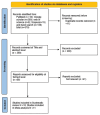Prevalence of toxin exposure in regions of Saudi Arabia: A systematic review and meta-analysis
- PMID: 40785961
- PMCID: PMC12331187
- DOI: 10.4103/jfcm.jfcm_337_24
Prevalence of toxin exposure in regions of Saudi Arabia: A systematic review and meta-analysis
Abstract
Poisoning is a growing significant concern globally. The increased use of industrial and household chemicals, together with widespread consumption of pharmaceuticals and processed foods, elevates the risk of toxic exposure worldwide. This study aimed to assess the frequency of toxic exposure by examining poisoning events in different regions of Saudi Arabia. A systematic literature review was conducted using PubMed, Web of Science, Scopus, and Google Scholar to identify studies on toxins and their prevalence in Saudi Arabia from 2004 to 2024. A meta-analysis was performed using R software, and the AXIS risk of bias was evaluated. Eighteen studies met the inclusion criteria for the systematic review, and eleven of these contributed data to the meta-analysis. Pooled prevalence for synthetic drugs was: cannabis 0.40 (95% confidence interval [CI]: 0.13-0.75), amphetamines 0.34 (95% CI: 0.05-0.85), and solvents 0.04 (95% CI: 0.02-0.07). Pooled prevalence for industrial chemicals was: chemical poisoning 0.16 (95% CI: 0.10-0.25), drug overdose 0.51 (95% CI: 0.38-0.65), and food 0.26 (95% CI: 0.22-0.29). Pooled prevalence for natural toxins was: carbon monoxide 0.76 (95% CI: 0.66-0.85), botulinum 0.42 (95% CI: 0.20-0.67), and scorpion stings 0.72 (95% CI: 0.24-0.95). The study highlights the diverse substances that cause acute poisoning in Saudi Arabia, with regional variations in toxin types and associated risks. Carbon monoxide was the most prevalent natural toxin (0.76), followed by scorpion stings (0.72). Drug overdose showed the highest prevalence of synthetic and chemical agents (0.51). Other notable toxins included botulinum (0.42), cannabis (0.40), and amphetamines (0.34). Industrial chemicals (0.16) and food-related toxins (0.26) also contributed to the issue. The findings highlight the need for public education programs on safe chemical and drug use. The future research should focus on risk factors, prevention, and the improvement of access to medical care.
Keywords: Exposure; Saudi Arabia; prevalence; toxins.
Copyright: © 2025 Journal of Family and Community Medicine.
Conflict of interest statement
There are no conflicts of interest.
Figures




Similar articles
-
Prevalence and Predictors of Diabetic Retinopathy in Saudi Arabia: Insights from a Systematic Review and Meta-Analysis.Biomolecules. 2024 Nov 22;14(12):1486. doi: 10.3390/biom14121486. Biomolecules. 2024. PMID: 39766193 Free PMC article.
-
Botulinum toxins for the prevention of migraine in adults.Cochrane Database Syst Rev. 2018 Jun 25;6(6):CD011616. doi: 10.1002/14651858.CD011616.pub2. Cochrane Database Syst Rev. 2018. PMID: 29939406 Free PMC article.
-
Health professionals' experience of teamwork education in acute hospital settings: a systematic review of qualitative literature.JBI Database System Rev Implement Rep. 2016 Apr;14(4):96-137. doi: 10.11124/JBISRIR-2016-1843. JBI Database System Rev Implement Rep. 2016. PMID: 27532314
-
Botulinum toxin type B for cervical dystonia.Cochrane Database Syst Rev. 2005 Jan 25;(1):CD004315. doi: 10.1002/14651858.CD004315.pub2. Cochrane Database Syst Rev. 2005. Update in: Cochrane Database Syst Rev. 2016 May 13;(5):CD004315. doi: 10.1002/14651858.CD004315.pub3. PMID: 15674941 Updated.
-
Heated tobacco products for smoking cessation and reducing smoking prevalence.Cochrane Database Syst Rev. 2022 Jan 6;1(1):CD013790. doi: 10.1002/14651858.CD013790.pub2. Cochrane Database Syst Rev. 2022. PMID: 34988969 Free PMC article.
References
-
- Ramírez-Malule H, Quiñones-Murillo DH, Manotas-Duque D. Emerging contaminants as global environmental hazards. A bibliometric analysis. Emerg Contam. 2020;6:179–93.
-
- Rosenfeld PE, Feng LG. Emerging contaminants. In: Hesketh H, editor. Risks of Hazardous Wastes. Oxford, England: Elsevier; 2011. pp. 215–22.
-
- Shannon MW, Borron SW, Burns MJ. Emergency management of poisoning. In: Haddad LM, Winchester JF, editors. Haddad and Winchester's Clinical Management of Poisoning and Drug Overdose. 4th ed. Philadelphia, PA: Elsevier Saunders; 2007. pp. 13–61.
Publication types
LinkOut - more resources
Full Text Sources
Miscellaneous
